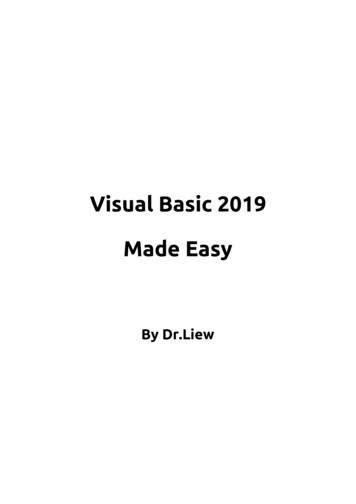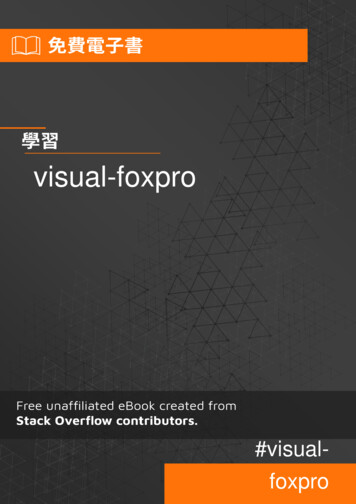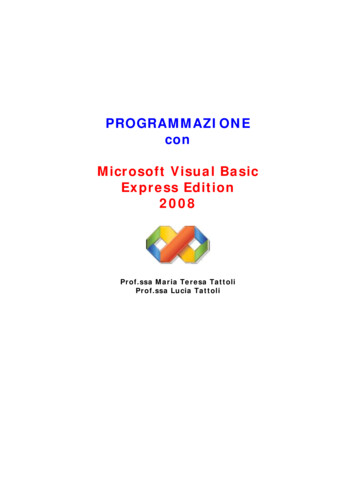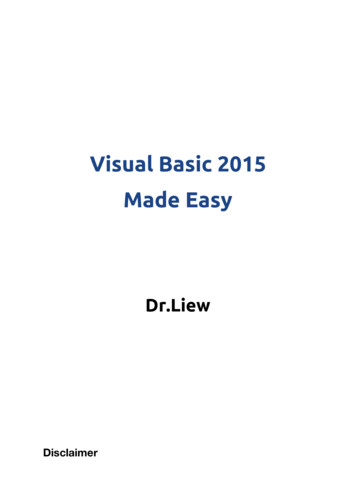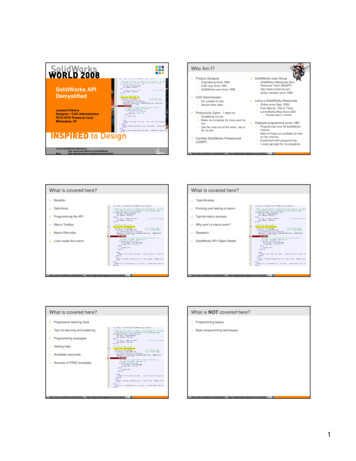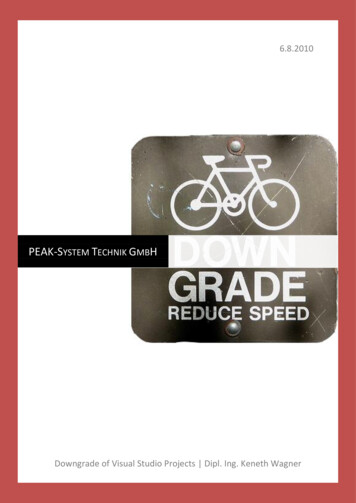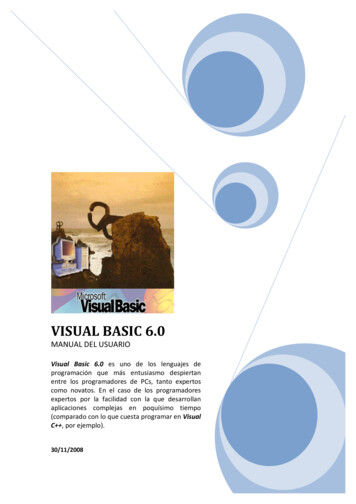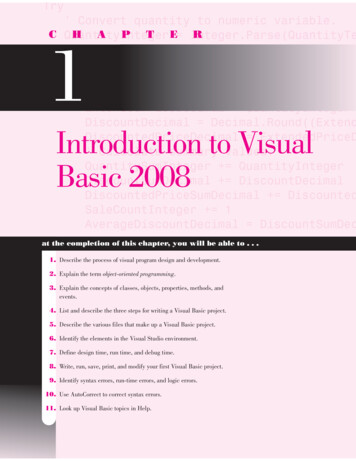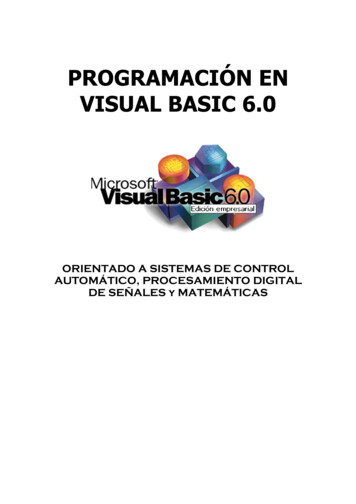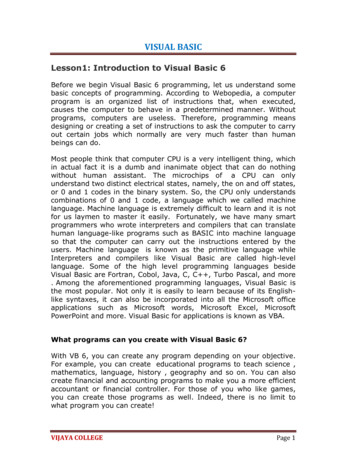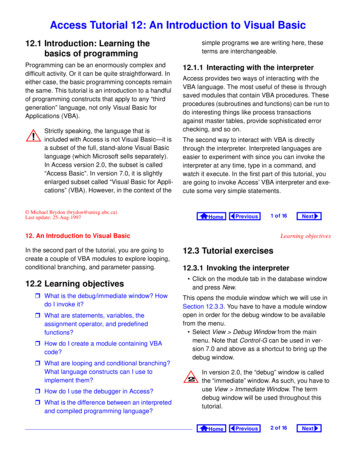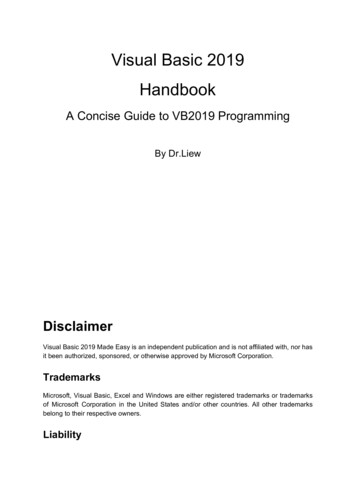
Transcription
Visual Basic 2019HandbookA Concise Guide to VB2019 ProgrammingBy Dr.LiewDisclaimerVisual Basic 2019 Made Easy is an independent publication and is not affiliated with, nor hasit been authorized, sponsored, or otherwise approved by Microsoft Corporation.TrademarksMicrosoft, Visual Basic, Excel and Windows are either registered trademarks or trademarksof Microsoft Corporation in the United States and/or other countries. All other trademarksbelong to their respective owners.Liability
The purpose of this book is to provide basic guides for people interested in Visual Basic2019 programming. Although every effort and care has been taken to make the informationas accurate as possible, the author shall not be liable for any error, Harm or damage arisingfrom using the instructions given in this book.Copyright 2019 Liew Voon KiongAll rights reserved. No Part of this e-book may be reproduced in any form or by any means,without permission in writing from the author.AcknowledgementI would like to express my sincere gratitude to the many people who have made theircontributions in one way or another to the successful publication of this book.My special thanks go to my children Xiang, Yi and Xun who have contributed their ideas andhelp in editing this book. I would also like to appreciate the support provided by my belovedwife Kim Huang and my youngest daughter Yuan. I would also like to thank the millions ofreaders who have visited my Visual Basic Tutorial website at vbtutor.net for their supportand encouragement.About the AuthorDr. Liew Voon Kiong holds a bachelor’s degree in Mathematics, a master’s degree inManagement and a doctorate in Business Administration. He has been involved in VisualBasic programming for more than 20 years. He created the popular online Visual BasicTutorial at www.vbtutor.net , which has attracted millions of visitors since 1996. It hasconsistently been one of the highest ranked Visual Basic websites.To provide more support for Visual Basic students, teachers, and hobbyists, Dr. Liew haswritten this book to complement the free Visual Basic 2019 tutorial with much more content.He is also the author of the Visual Basic Made Easy series, which includes Visual Basic 6Made Easy, Visual Basic 2008 Made Easy, Visual Basic 2010 Made Easy, Visual Basic2013 Made Easy, Visual Basic 2015 Made Easy, Visual Basic 2017 Made Easy and ExcelVBA Made Easy. Dr.Liew’s books have been used in high school and university computerscience courses all over the world.ContentsDisclaimer 1
Trademarks. 1Liability. 1Acknowledgement 2About the Author 2Chapter 1 Introduction to Visual Basic 2019. 141.1 A Brief History of Visual Basic. 141.2 Installation of Visual Studio 2019. 151.3 Creating a Visual Basic 2019 Project 17Chapter 2 Designing the User Interface. 262.1 Customizing the Form. 262.2 Adding Controls to the Form. 33Chapter 3 Writing the Code. 383.1 The Concept of Event-Driven Programming. 383.2 Writing the Code. 40Chapter 4 Working with Controls. 434.1 TextBox . 43Example 4.1. 434.2 Label 45Example 4.2. 454.3 ListBox . 474.3.1 Adding Items to a Listbox . 47a) Adding items using the String Collection Editor 47b) Adding Items using the Add() Method. 49Example 4.3. 49Example 4.4. 50Example 4.5 Geometric Progression. 52
4.3.2 Removing Items from a List Box . 54Example 4.5. 55Example 4.6. 56Example 4.7. 57Example 4.8. 59Example 4.9. 604.4 ComboBox. 614.4.1 Adding Items to a ComboBox . 624.4.2 Removing Items from a Combobox . 66Chapter 5 Handling Images. 685.1 Loading an Image in a Picture Box. 685.1.1 Loading an Image at Design Time. 685.1.2 Loading an Image at Runtime. 715.2 Loading an Image in a Picture Box using Open File Dialog Control 72Chapter 6 Working with Data. 766.1 Visual Basic 2019 Data Types. 766.1.1 Numeric Data Types. 76Table 6.1: Numeric Data Types. 776.1.2 Non-numeric Data Types. 78Table 6.2 Non-numeric Data Types. 786.1.3 Suffixes for Literals. 78Table 6.3 Suffixes and Data Types. 796.2 Variables and Constants. 796.2.1 Variable Names. 806.2.2 Declaring Variables. 80Example 6.1. 81
Example 6.2. 81Example 6.3. 826.2.3 Assigning Values to Variables. 83Example 6.4. 846.2.4 Scope of Declaration. 856.2.5 Declaring Constants. 85Example 6.5 . 86Chapter 7 Arrays. 887.1 Introduction to Arrays. 887.2 Dimension of an Array. 887.3 Declaring Arrays . 89Example 7.1. 90Example 7.2. 91Example 7.3. 91Example 7.4. 92Chapter 8 Mathematical Operations. 948.1 Mathematical Operators . 948.2 Writing Code for Mathematical Operations. 95Example 8.1 Standard Arithmetic Calculations. 95Example 8.2 Pythagorean Theorem . 96Example 8.3: BMI Calculator 96Chapter 9 String Manipulation. 1009.1 String Manipulation Using and & signs . 100Example 9.1. 100Example 9.2. 1019.2 String Manipulation Using Built-in Functions. 103
9.2 (a) The Len Function. 103Example 9.3. 1039.2(b) The Right Function. 104Example 9.4. 1049.2(c) The Left Function. 1059.2 (d) The Mid Function. 105Example 9.5. 106Example 9.6. 1069.2(e) Trim Function. 107Example 9.7. 1089.2(f) Ltrim Function. 1089.2(g)The Rtrim Function. 1089.2(h) The InStr function. 1099.2(i) The Ucase and the Lcase Functions. 1099.2(j) The Chr and the Asc functions. 110Chapter 10 Using If Then Else. 11110.1 Conditional Operators. 11110.2 Logical Operators. 11210.3 Using If .Then.Else. 11310.3(a) If.Then Statement 113Example 10.1. 11310.3(b) If.Then Else Statement 114Example 10.2. 114Example 10.3. 11810.3(c) If.Then.ElseIf Statement 120Example 10.4 Grade Generator 121
Chapter 11 Using Select Case. 12311.1 The Select Case End Select Structure. 12311.2 The usage of Select Case. 124Example 11.1: Examination Grades. 124Example 11.2. 125Example 11.3. 126Example 11.4. 127Chapter 12 Looping. 12912.1 For.Next Loop. 129Example 12.1 a. 130Example 12.1b. 130Example 12.1c. 130Example 12.1d. 13112.2 Do Loop. 131Example 12.2(a) 132Example 12.2(b) 13312.3 While.End While Loop. 134Example 12.3. 135Chapter 13 Sub Procedures. 13613.1 What is a Sub Procedure . 13613.2 Examples of Sub Procedure . 136Example 13.1. 136Example 13.2: Password Cracker 138Chapter 14 Creating Functions. 14214.1 Creating User-Defined Functions . 142Example 14.1: BMI Calculator 143
Example 14.2: Future Value Calculator 14414.2 Passing Arguments by Value and by Reference. 146Example 14.2(a) 147Chapter 15 Mathematical Functions. 15015.1 The Abs Function. 150Example 15.1. 15015.2 The Exp function. 151Example 15.2. 15215.3 The Fix Function. 153Example 15.3. 15315.4 The Int Function. 15415.5 The Log Function. 154Example 15.4. 15515.6 The Rnd( ) Function. 155Example 15.5. 15615.7 The Round Function. 157Example 15.6. 157Chapter 16 The Format Function. 15916.1 Format Function for Numbers. 15916.1(a) Built-in Format function for Numbers . 159Example 16.1. 16016.1(b) User-Defined Format 161Example 16.2. 16316.2 Formatting Date and Time. 16416.2(a) Formatting Date and time using predefined formats. 164Example 16.3. 165
16.2(b) Formatting Date and time using user-defined formats. 166Example 16.4. 167Chapter 17 Using Checkbox and Radio Button. 17017.1 Check Box. 170Example 17.1: Shopping Mall 170Example 17.2. 173Example 17.3. 17317.2 Radio Button. 176Example 17.4. 176Example 17.5. 178Chapter 18 Errors Handling. 18218.1 Introduction to Object Oriented Programming. 18218.2 Using On Error GoTo Syntax. 183Example 18.1: Division Errors. 18318.3 Errors Handling with Try Catch .End Try Structure. 185Chapter 19 Object Oriented Programming. 18719.1 Concepts of Object-Oriented Programming. 187(a) Encapsulation. 187(b) Inheritance. 187(c) Polymorphism. 18819.2 Creating Class. 188Chapter 20 Creating Graphics. 19420.1 Introduction to Graphics Creation. 19420.2 Creating the Graphics Object 19420.3 Creating the Pen Object 19520.4 Drawing a Line. 196
20.5 Drawing Lines that Connect Multiple Points. 198Example 20.1. 19820.6 Drawing a curve that Connect Multiple Points. 200Example 20.2. 20020.7 Drawing a Quadratic Curve. 202Example 20.3. 20220.8 Drawing a Sine Curve. 204Example 20.4. 20520.9 Drawing a Rectangle. 20620.10 Customizing Line Style of the Pen Object 208Example 20.5. 20820.11 Drawing an Ellipse. 210Example 20.6. 212Example 20.7. 21320.12 Drawing a Circle. 213Example 20.8. 214Example 20.9. 21420.13 Drawing Text 215Example 20.10. 216Example 20.11. 21820.14 Drawing Polygons. 219Example 20.12 Drawing a Triangle. 220Example 20.13 Drawing a Quadrilateral 22220.15 Drawing a Pie. 223Example 20.14 Drawing a pie that sweeps clockwise through 60 degrees. 22420.16 Filling Shapes with Color 224
20.16(a) Drawing and Filling a Rectangle with Color 225Example 20.15. 22520.16(b) Drawing and Filling an Ellipse with Color 227Example 20.16. 22720.16(c) Drawing and Filling a Polygon with Color 228Example 20.17. 22820.16(d) Drawing and Filling a Pie. 229Example 20.18. 230Chapter 21 Using Timer 23121.1 Creating a Digital Clock. 23121.2 Creating a Stopwatch. 23321.3 Creating a Digital Dice. 235Chapter 22 Creating Animation. 23822.1 Creating Motion. 23822.2 Creating a Graphical Dice. 24022.3 Creating a Slot Machine. 243Chapter 23 Working with Databases. 24723.1 Introduction to Database. 24723.2 Creating a Database Application. 24823.3 Creating a Connection to a Database using ADO.NET. 24923.4 Populating Data in ADO.NET. 257Example 23.1. 25923.5 Browsing Records. 26223.6 Editing, Saving, Adding and Deleting Records. 263Example 23.2. 26423.7 Accessing Database using DataGridView. 269
Example 23.3. 27023.8 Performing Arithmetic Calculations in a Database. 271Example 23.4. 272Example 23.5. 273Example 23.6. 276Chapter 24 Reading and Writing Text Files. 27924.1 Introduction. 27924.2 Reading a Text File. 27924.3 Writing to a Text File. 284Chapter 25 Building Console Applications. 28725.1 Introduction. 287Example 25.1: Displaying a Message. 29025.2 Creating a Text File Writer in Console. 291Example 25.2. 29225.3 Creating a Text File Reader in Console. 293Example 25.3. 29325.4 Creating a Console App using If.Then.Else. 294Example 25.4. 294Chapter 26 Creating Menu Bar and Toolbar 29726.1 Creating Menu Items on the Menu Bar 29726.2 Creating the Toolbar 308Chapter 27 Deploying your VB 2019 Applications. 316Index. 322
Chapter 1 Introduction to Visual Basic20191.1 A Brief History of Visual BasicVisual Basic is a third-generation event-driven programming language first released byMicrosoft in 1991. The final version of the classic Visual Basic was Visual Basic 6. VisualBasic 6 is a user-friendly programming language designed for beginners. Therefore, itenables anyone to develop GUI Windows applications easily. Many developers still favorVB6 over its successor VB.NET.In 2002, Microsoft released Visual Basic.NET (VB.NET) to replace Visual Basic 6.Thereafter, Microsoft declared VB6 a legacy programming language in 2008. However,Microsoft still provides some form of support for VB6. VB.NET is a fully object-orientedprogramming language implemented in the .NET Framework. It was created to cater for thedevelopment of the web as well as mobile applications. Subsequently, Microsoft hasreleased many versions of VB.NET. They are Visual Basic 2005, Visual Basic 2008, VisualBasic 2010 , Visual Basic 2012, Visual Basic 2013 , Visual Basic 2015, Visual Basic 2017and Visual Basic 2019 . Although the .NET portion was discarded in 2005, all versions ofthe Visual Basic programming language released since 2002 are regarded as the VB.NETprogramming languageMicrosoft has released Visual Studio 2019 in early 2019. VS 2019 allows you to code indifferent programming languages and different platforms, Visual Basic 2019 is one of them.The other Programming languages are C#, C , F#, JavaScript, Java and Python. VisualBasic 2019 is the latest version VB.NET programming language released by Microsoft.Learn more about Visual Studio 2019 from the Youtube link below:https://youtu.be/n5sJ4EewKGk1.2 Installation of Visual Studio 2019You can download the free version of Visual Studio 2019 from the following g the link brings up the Visual Studio 2019 download page, as shown below:
Figure 1.1You can choose the free Visual Studio Community 2019 or the Full-featured Professional2019 and End-to-End solution Enterprise 2019 to download. The free version that providesfull-featured IDE for students, open source community and individuals. As this book waswritten based on the free version, proceed to download the free Visual Studio 2019Community, select community, and download the installer file. The downloaded installer filewill appear on your Windows 10 taskbar. Click it to install Visual Studio 2019. Clicking theVisual Studio 2019 Installer will start downloading, unpacking, and installing the filesnecessary for the installation of Visual Studio 2019, as shown in Figure 1.2Figure 1.2You will see several status screens that show the progress of the installation. After theinstaller has finished installing, it is time to pick the feature set that you wish to install, asshown in Figure 1.3. Since we are focusing on developing Visual Basic 2019 desktop app,we will select the .NET desktop development component. After making your selections, clickinstall.Figure 1.3Upon completion of the installation, you are now ready to launch Visual Studio 2019 andstart programming in Visual Basic 20191.3 Creating a Visual Basic 2019 ProjectLaunching Microsoft Visual Studio 2019 will bring you to the Visual Studio 2019 Start Page,as shown in Figure 1.4Figure 1.4 Visual Studio 2019 Start PageThe Visual Studio 2019 start page comprises two sections, the Open Recent section, andthe Get Started section. In the start page, you can select a recent project file or choose any
option in the Get Started section. You can choose to clone a project from GitHub or AzureDevOps, open a project or solution, open a local folder, create a new project, or continuewithout code.Let us create a new project by clicking on the Create a new project option. You will now seethe Create a new project template page, as shown in Figure 1.5. In the Create a new projectpage, select the Visual Basic language.Figure 1.5 Create a new project templateNext, select the Windows Forms App (.Net Framework) template as we want to develop aWindows desktop project, as shown in Figure 1.6Figure 1.6 Create a new project templateUpon clicking the selected project template, the project configuration page appears, asshown in Figure 1.7. You can configure your project by typing the project name and select afew other options.Figure 1.7 Configuring ProjectAt the bottom of this dialog box, you can change the default project nameWindowsApplication1 to some other name you like, for example, My First Visual Basic 2019App. After renaming the project, click OK to continue. The Visual Basic 2019 IDE Windowswill appear, as shown in Figure 1.8. Visual Basic 2019 IDE comprises a few windows, theForm window, the Solution Explorer window, and the Properties window. It also consists of atoolbox which contains many useful controls that allows the programmer to develop his orher Visual Basic 2019 programs.Figure 1.8 The Visual Basic 2019 Express IDEThe Toolbox is not shown until you click on the Toolbox tab. When you click on the Toolboxtab or use the shortcut keys Ctrl Alt x, the common controls Toolbox will appear, as shownin Figure 1.9. You can drag and move your toolbox around and dock it to the right, left, top orbottom of the IDE.Figure 1.9 Visual Basic 2019 Toolbox
Next, we shall proceed to show you how to create your first VB2019 application. First,change the text of the form to ‘My First VB 2019 App’ in the properties window; it will appearas the title of the application. Next, insert a button and change its text to OK. The designinterface is shown in Figure 1.10Figure 1.10 The Design InterfaceNow click on the OK button to bring up the code window and enter the following statementbetween Private Sub and End Sub procedure, as shown in Figure 1.11.MsgBox("My First Visual Basic 2019 App")Clicking the Start button on the toolbar or press F5 to run the application will launch theruntime interface, as shown in Figure 1.11. Executing the application by clicking on the OKbutton will bring up a dialog box that displays the “My First Visual Basic 2019 App″ message,as shown in Figure 1.12. The function MsgBox is a built-in function of Visual Basic 2019which can display the text enclosed within the brackets.Figure 1.11 Visual Basic 2019 Code WindowFigure 1.12 The Runtime InterfaceFigure 1.13 The Message BoxSummary Insection 1.1, you have learned about the history of Visual Basic 2019 Insection 1.2, you have learned how to install and launch Visual Basic Studio 2019 In section 1.3, you have learned how to launch the new project dialog and the VisualBasic 2019 IDE. You have also learned how to write your first program.Chapter 2 Designing the User Interface
As Visual Basic 2019 is a GUI-based programming language, the first step in developing anapplication is to design the user interface (UI). To build a graphical user interface, first of allyou need to customize the default form by changing its properties at design phase and atruntime, including its name, title, background color and so forth. After customizing the defaultform, you may proceed to add controls from the toolbox to the form and then customize theirproperties.2.1 Customizing the FormWhen you start a new Visual Basic 2019 project, the VB2019 IDE will display the defaultform along with the Solution Explorer window and the Properties window, as shown in Figure2.1. The name of the default form is Form1. The properties window displays all theproperties related to Form1 and their corresponding attributes or values. You can change thename of the form, the title of the form using the text property, the background color, theforeground color, size and more. Try changing the following properties :PropertyValueNameMyFormTextMy First VB2019 oxFalseIn fact, you do not have to type in the color manually, you can indeed select a color from thecolor drop-down list that comprises three tabs, Custom, Web, and System, as shown inFigure 2.1. Clicking on the drop-down arrow will bring out a color palette or a list of colorrectangles where you can select a color.Figure 2.1Another method of setting the colors is to manually type in the RGB color code or the hexcolor code. The values of R, G and B ranges from 0 to 255, therefore, by varying the valuesof the RGB we can obtain different colors. For example, an RGB value of 128, 255, 255 yieldthe cyan color.
On the other hand, the hex color code system uses a six-digit, three- byte hexadecimalnumber to represent colors. The bytes represent the red, green and blue components of thecolor. One byte represents a number ranging from 00 to FF (in hexadecimal notation), or 0 to255 in decimal notation. For example, #0000ff represents the cyan color. However, whenyou type the Hex color code in the properties window of VS2019, it automatically convertsthe color to RGB color or the color name. Figure 2.2 shows a list of Hex color codes and thecorresponding colors.Figure 2.2 Hex Color CodesThe design interface is shown in Figure 2.2 and the runtime interface is shown in Figure 2.4.In the runtime interface, notice that the title has been changed from Form1 to My First VisualBasic 2019 App, background color changed to LavenderBlush , the text OK color is Crimsonand the window cannot be maximized.Figure 2.3 Design UIFigure 2.4 Runtime UIYou can also change the properties of the form at runtime by writing the relevant codes. Thedefault form is an object and an instant of the form can be denoted by the name Me. Theproperty of the object can be defined by specifying the object’s name followed by a dot orperiod:ObjectName.propertyFor example, we can set the background of the form to blue using the following code:Me. BackColor Color . BlueIn addition, you can also use the FromArgb method to specify the color using the RGBcodes, as follows:Me .BackColor Color.FromArgb(0, 255, 0)Now, type in the following code by clicking the form to enter the code window:
Private Sub Form1 Load (sender As Object , e As EventArgs) Handles MyBase .LoadMe . Text "My First Visual Basic 2019 Application"Me .BackColor Color.TurquoiseMe .ForeColor Color.IvoryMyBtn.BackColor Color.DodgerBlueMe .MaximizeBox FalseMe .MinimizeBox TrueEnd SubTo runtime UI is shown in Figure 2.5. Notice that is is now different from that shown in Figure2.4,Figure 2.5In place of Turquoise, you can use RGB code as follows:Me .BackColor Color.FromA rgb(64,224,208)In addition, you can also specify the size, the opacity and the position of the default formusing the code, as follows:
Private Sub Form1 Load(sender As Object , e As EventArgsHandles MyBase .LoadMe . Text "My First VB2019 App"Me .BackColor Color.BeigeMe .MaximizeBox FalseMe .MinimizeBox TrueMe .Size New Size(400, 400)Me .Opacity 0.85Me .CenterToParent()End SubThe property Opacity sets the degree of transparency. The runtime interface is as shown inFigure 2.6Figure 2.62.2 Adding Controls to the FormIn section 2.1, we have learned how to build an initial UI in Visual Basic 2019 by customizingthe default form. Next, we shall continue to build the UI by adding some controls to the form.The controls are objects that consist of three elements, namely properties, methods, andevents. They can be added to the form from the Toolbox. Among the controls, the mostcommon ones are the button, label, textbox, listbox, combobox, picture box, checkbox, radiobutton and more. These controls can be made visible or invisible at runtime. However, somecontrols will only run in the background and never be seen at runtime, one such control isthe timer.The Toolbox is usually hidden when you start Visual Basic 2019 IDE, you need to click Viewon the menu bar and then select Toolbox to reveal the tool box, as shown in Figure 2.6. Youcan also use shortcut keys Ctrl w x to bring out the toolbox.Figure 2.6: Toolbox
You can position the Toolbox by dragging it anywhere you like while its status is set to float.You can also dock the toolbox by right-clicking on the Toolbox and choose dock from thepop-up menu. The docked Toolbox that appears side by side with the Solution Explorer, andas one of the tabbed windows together with the Form Design window and the code window,as shown in Figure 2.7.Figure 2.7 ToolboxYou can also dock the Toolbox at the bottom, below the default form, as shown in Figure2.8. Further, you may also pin the Toolbox to the side bar or the bottom bar by clicking onthe pin icon on the menu bar of the toolbox.How and where you want to position your tool box is entirely up to you but we stronglysuggest that you place the tool box alongside or at the bottom of the default form so that it iseasy for you to add controls from the tool box into the form. You should never cover the formwith the Toolbox because it will be difficult to add controls to the form.Figure 2.8Adding a control to the form is an easy task, what you need to do is double click it or drag itonto the form. You can drag the control around the form, and you can also resize it.To demonstrate how to add the controls and then change their properties, we shall design apicture viewer. First, change the title of the default form to Picture Viewer in its propertieswindow. Next, insert a picture box on the form and change its background color to white. Todo this, right click the picture box and select properties in the popup menu, then look for theBackColor Property as shown in the properties window in Figure 2.9. Finally, add twobuttons to the form and change the text to View and Close in their respective propertieswindows. The picture viewer is not functional yet until we write code for responding to eventstriggered by the user. We will deal with the programming part in the coming chapters.Figure 2.9Summary Insection 2.1, you have learned how to customize the form by changing the valuesof its properties. In section 2.2, you have learned how to add controls to the form and change theirproperties at design phase and at runtime.
Chapter 3 Writing the CodeIn the previous chapter, we have learned how to design the user interface by adding controlsto the form and by changing their properties. However, the user interface alone will not workwithout adding code to them. In this chapter, we shall learn how to write code for all thecontrols so that they can interact with the events triggered by the users. Before learning howto write Visual Basic 2019 code, let us delve into the concept of event-driven programming3.1 The Concept of Event-Driven ProgrammingVisual Basic 2019 is an event-driven programming language meaning that the code isexecuted in response to events triggered by the user like clicking the mouse, pressing a keyon the keyboard, selecting an item from a drop-down list, typing some words into text boxand more. It may also be an event that runs in response to some other program. Some ofthe common events in Visual Basic 2019 are load, click, double-click, drag-drop, keypressand more.Every form and every control you place on the form has a set of events related to them. Toview the events, double-click the control on the form to enter the code window. The defaultevent will appear at the top part on the right side of the code window. You need to click onthe default event to view other events associated with the control. The code appears on theleft side is the event procedure associated with the load event. Figure 3.1 illustrates theevent procedure Load associated with the Form (its name has been changed to PicViewertherefore you can see the words PicViewer events) and Figure 3.2 shows the eventsassociated with button.Figure 3.1: Events associated with FormFigure 3.2: Events associated with the button3.2 Writing the CodeTo start writing code in Visual Basic 2019, click on any part of the form to go into the codewindow as shown in Figure 3.1. The event procedure is to load Form1 and it starts with thekeywords Private Sub and ends with End Sub . This procedure includes the Form1 classand the event Load, and they are bound together with an underscore, i.e. Form Load . Itdoes nothing other than loading an empty form. To make the load event does something,insert the statement.MsgBox ( "Welcome to Visual Basic 2019″)The Code
Public Class Form1Private Sub Form1 Load(sender As Object, e As EventArgs)Handles MyBase. LoadMsgBox (“My First Visual Basic 2019 APP", ,"My Message")End SubEnd ClassMsgBox is a built-in function in Visual Basic 2019 that displays a message in a pop-upmessage box. The MsgBox function comprises a few arguments, the first being the messagethat is displayed and the third one is the title of the message box. When you run theprogram, a message box displaying the text “My First Visual Basic 2019 APP” will appear, asshown in Figure 3.3.Figure 3.3You will notice that above the Private Sub structure there is a preceding keyword PublicClass Form1 . This is the concept of the object-oriented programming language. When westart a windows application in Visual Basic 2019, we will see a default form with the nameForm1 appears in the IDE, it is actually the Form1 Class that inherits from the Form classSystem.Windows.Forms.Form . A class has events as it creates an instant of a class or anobject.You can also write code to perform arithmetic calculations. For example, you can use theMsgBox and the arithmetic operator plus to perform addition of two numbers, as s hownbelow:Private Sub Form1 Load(sender As Object , e As EventArgs)Handles MyBase .LoadMsgBox("2" & " " & "5" & " " & 2 5)End Sub*The symbol & (ampersand) is to perform string concatenation. The output is as shown inFigure 3.4
Figure 3.4Summary Insection 3.1, you have learned the concepts of event driven programming Insection 3.2, you have learned how to write code for the controlsChapter 4 Working with ControlsIn the preceding chapter, we have learned how to write simple Visual Basic 2019 code. Inthis lesson, we shall learn how to work with some common controls and write codes forthem. Some of the commonly used controls are Label, TextBox, Button, ListBox andComboBox. However, in this chapter, we shall only deal with TextBox , Label, ListBox andComboBox. We shall deal with the other controls later.4.1 TextBoxTextBox is the standard control for accepting inputs from the user as well as to display theoutput. It can handle string (text) and numeric data but not images or pictures. String in aTextBox can be converted to a numeric data by using the function Val(text) . The followingexample illustrates a simple program that processes the input from the user.Example 4.1In this program, you add two text boxes and a button on the form. The two text boxes are foraccepting inputs from the user. Besides that, we can also program a button to calculate thesum of the two numbers using the plus operator. The value entered into a TextBox is storedusing the syntax TextBox1.Text , where Text is one of the properties of TextBox.The following code will add the value in TextBox1 and the value in TextBox2 and displaysthe sum in a message box. The runtime interface is illustrated in Figure 4.1.
Private Sub Button1 Click(sender As Object , e As EventArgs) Handles Button1.Click MsgBox( "The sum is" & Val (TextBox1.Text) Val(TextBox2.Text))End SubFigure 4.1After clicking the Add button, you will obtain the answer in a message box, as shown inFigure 4.2.Figure 4.24.2 LabelLabel is an especially useful control for Visual Basic 2019 because we can use it for multiplepurposes like providing instructions and guides to the users, displaying outputs and more. Itis different from the TextBox because it is read only, which means t
Chapter 1 Introduction to Visual Basic 2019. 14 1.1 A Brief History of Visual Basic. 14 1.2 Installation of Visual Studio 2019. 15 1.3 Creating a Visual Basic 2019 Project 17 Chapter 2 Designing the User Interface. 26 2.1 Customizing the Form. 26 2.2 Adding Controls to the Form. 33 Chapter 3 Writing the Code. 38
